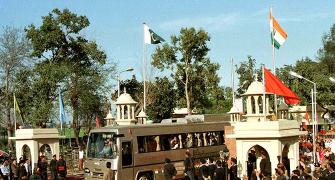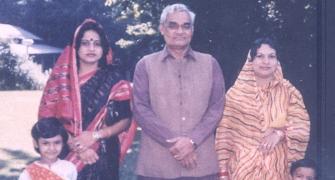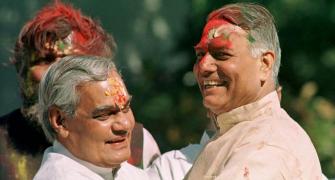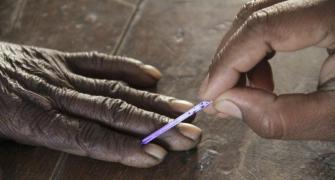Atal Bihari Vajpayee was often described as the "mukhauta", the agreeable and affable mask presented by the Bhartiya Janata Party to the outside world.
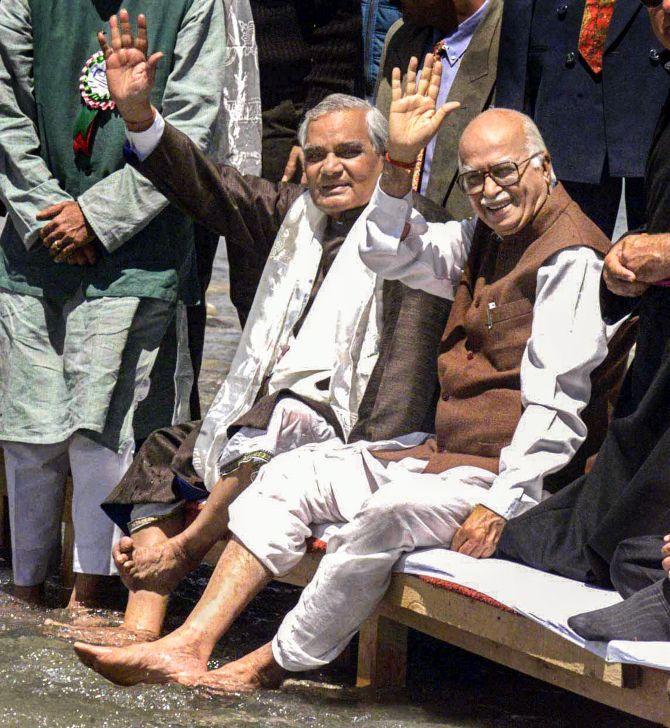
If that were so, the real face behind it was that of L K Advani, the original mass hero of Hindutva.
Together they pulled the Bharatiya Janata Party from the fringes of anti-Congress politics to the national centre-stage, increasing the party's strength in Lok Sabha from two seats in 1984 to 182 seats in 1999.
So great was their influence that 'Atal-Advani' became a collective sobriquet often used by politicians and experts to describe the BJP leadership of 1990s and early 2000s.
With Vajpayee passing away, Advani, 90, remains alone among the stalwarts of that generation of BJP leaders who have now been replaced by the new leadership headed by Prime Minister Narendra Modi, whose popularity perhaps exceeds that of the mentors.
"Advani's Ram temple movement had generated a mass support for the party it had never seen earlier," said a BJP leader, speaking on condition of anonymity because of the sensitivity of the subject. "But Vajpayee was the right person to take the party to the next level," he said.
In a fond tribute, Advani remembered his memories of long association with Vajpayee through their days as Rashtriya Swayamsevak Sangh pracharaks, Jana Sangh leaders, struggle during the Emergency and then as colleagues in the BJP.
"To me Atal ji was more than a senior colleague -- in fact he was my closest friend for over 65 years," said Advani, who, more than Vajpayee, was instrumental in fashioning the party's rise by bringing to front the agenda of building Ram temple in Ayodhya and mobilising the masses across large parts of the country with his 'rath yatra' in 1990.
Never a proponent of aggressive Hindutva and wary of 'kamandal' politics, as critics called the BJP's pro-temple politics, Vajpayee was not the go-to leader for the RSS, the ideological parent of BJP, for pushing its core agenda.
Vajpayee had to make way for Advani in 1986 as the party's president.
With 1989 elections approaching, the BJP under Advani adopted a resolution in its national executive in favour of building a Ram temple.
This coupled with its loose alliance with anti-Congress parties sent the BJP's tally soaring to 85 seats in Lok Sabha, higher than its earlier avatar Jana Sangh ever got, and then it jumped to 120 in 1991, riding the popular wave generated by 'Ram Janmabhoomi' movement.
At that point, Advani, who once worked as a secretary for Vajpayee, seemed the natural choice for the BJP's prime ministerial candidate.
But in what many believe to be an act of seminal political significance, he declared in a 1995 meeting in Mumbai that his senior colleague will be entrusted with the responsibility of prime ministership if the party comes to power.
Party veterans say that in the era of coalition politics, Vajpayee -- seen as a peacemaker and moderate face of his party -- was considered the right man by Advani to win over new allies as the BJP had become a pariah for regional parties following the demolition of Babri mosque in 1992.
"The organisation was completely under the sway of Advani but it was Vajpayee's wider acceptability among likely allies and the masses which appealed to the allies because he maintained a distance from hardline Hindutva," said a former BJP ally, also speaking on condition of anonymity.
If Advani's ideological leadership galvanised the party's cadres and core support, Vajpayee's soaring oratory, common touch, easy charm and convivial manners won over the masses and brought new allies on board.
Opposition leader Sharad Yadav, a key BJP ally for close to 15 years until 2013 and a minister in the Vajpayee's Cabinet, describes Vajpayee as the face of the saffron party and Advani as its builder.
"Both Vajpayee and Advani worked with national interest in mind but they were obviously different personalities", he said.
After BJP's rout in the 2004 elections, Vajpayee gradually faded from public life. Advani remained active and was his party's prime ministerial candidate in 2009 elections but the party fared poorly, prompting the RSS to look for a younger generation of leadership.
This paved the way for Modi.
In a sign of things to come, Advani who had masterminded the BJP's best ever showing in general elections, was overshadowed in 2014 when the Modi wave gave the party its first majority government.
Soon after, Advani was pushed out of the inner circle and made a member of the inconsequential Margdarshak Mandal, which has never convened.

